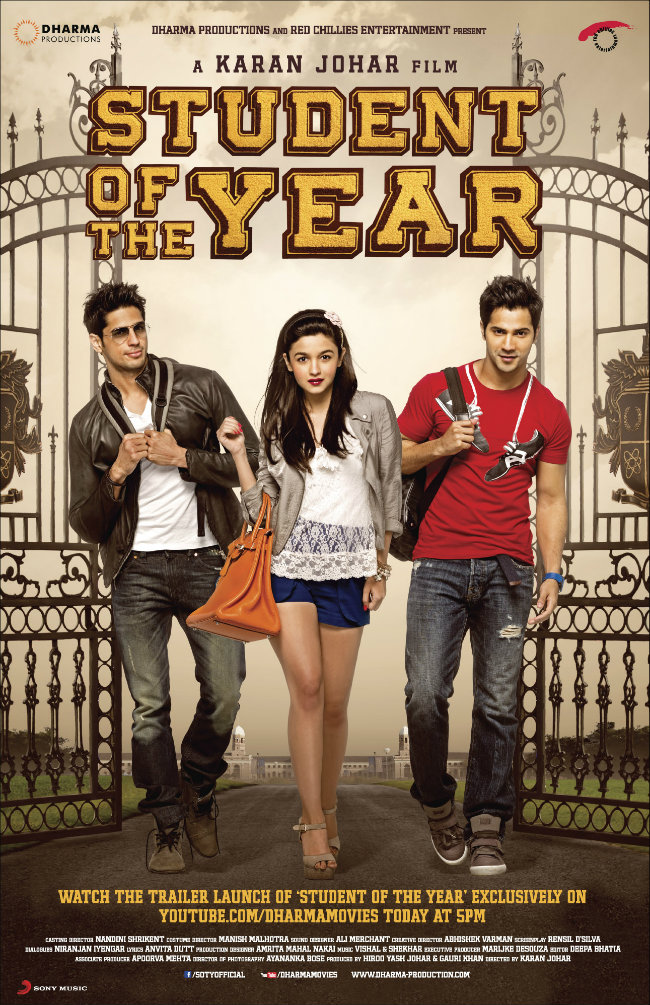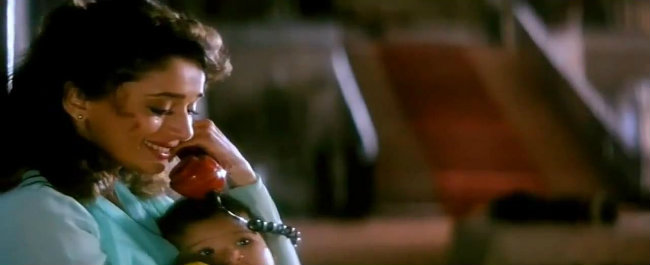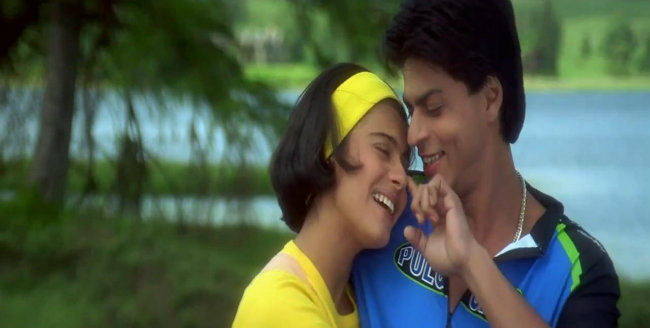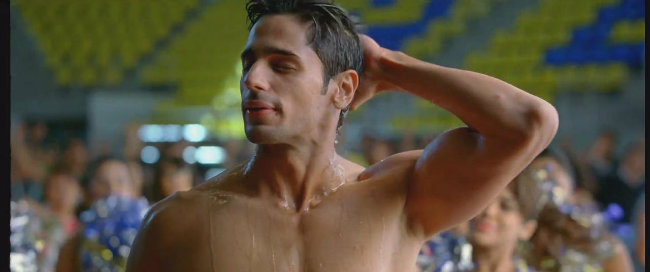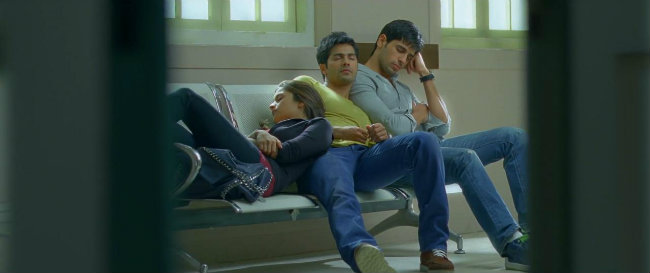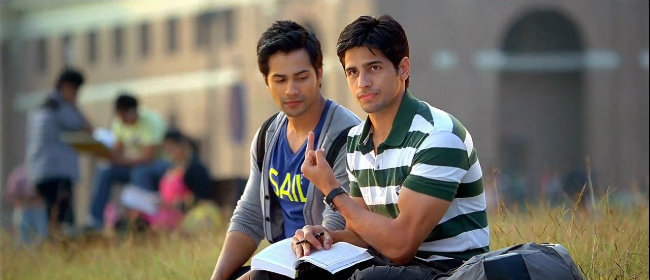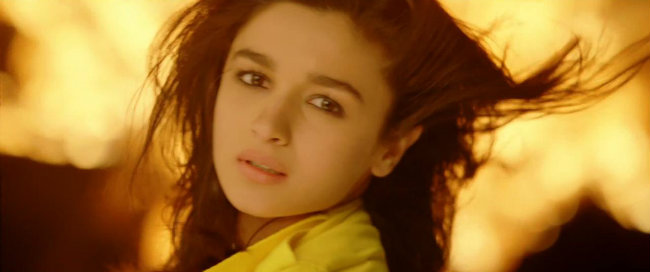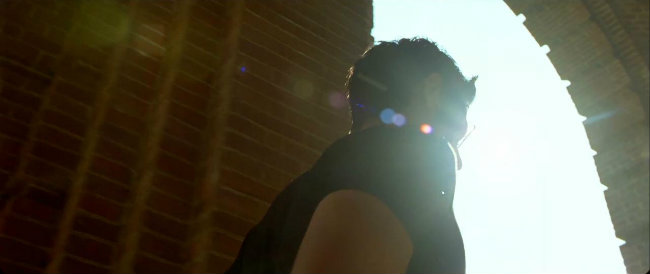Six miles away from my office is a theater that plays Bollywood movies simultaneously with their Indian release. This is one of them.
***
Student of the Year
Directed by Karan Johar, 2012
***
WHAT CAN WE GUESS THE FILM IS ABOUT FROM THE UNSUBTITLED TRAILER?
[]
Through the intercession of those occasional bursts of English common to Hindi-language films, the monoglot can discern that St. Teresa’s High School is India’s premiere academic institution. Thus grounded, the ensuing barrage of flailing bodies and flashing lights reveals two suspiciously adult-looking male students who are clearly in love, though the rigors of the recently-opened Student of the Year Competition (also in English) will cruelly rip them apart. Obviously this is all a metaphor for the sociopathy engendered by globalized capitalism in an emerging market, thereby revealing Karan Johar as a stealth Marxist – perhaps the stealthiest in history, judging from all those brand names. Also, there’s a girl and a burning tree.
***
WHAT IS THE HISTORY BEHIND THIS PICTURE?
In the beginning, i.e 1989, there was an auteur by the name of Sooraj R. Barjatya who, at the age of 24, with the might of a production company established by his grandfather behind him, directed a film titled Maine Pyar Kiya. Tracking the rich boy/poor girl romance of its protagonists through multiple societal and familial tribulations, the film was hardly the first of its kind — a similarly goopy (if more mechanical) hit titled Qayamat Se Qayamat Tak had debuted just one year prior — but it nonetheless struck a chord with a public tired of the generic excess that marked the Bollywood of the ’80s. Barjatya was young, and driven by a religious-minded zeal for wholesome entertainment steeped in traditional family values; his art was stylized and idealized, but intently focused on interpersonal dynamics.
He returned in 1994 with his magnum opus, Hum Aapke Hain Koun..!, a 200-minute, 14-song gargantuan sprawl of earthy romantic devotion that sparked a veritable revolution in Indian theatergoing – buffeted by the advent of home video, the movie house found unexpected salvation as a public venue for family togetherness. Box office receipts were fucking ridiculous.
Among the scores of industry personnel whose lids were flipped was Aditya Chopra, scion of Yash Raj Films, a production company that had left an indelible mark on Bollywood through the pastel romances of founder Yash Chopra. Emboldened by Barjatya’s success, the young Chopra, also aged 24, released his directorial debut in 1995: Dilwale Dulhania Le Jayenge, a savory bowl of cosmopolitan mush so popular that one particular Mumbai theater continued to run daily showings well into the 21st century. Yet while Barjatya’s films remained devoutly focused on Indian concerns, Chopra’s twist was to incorporate the non-resident Indian (“NRI”) experience into the action, positioning the Yash Raj brand as a global platform for homemade entertainment, aimed at monied Indian nostalgists and curious fellow travelers worldwide.
Most critical to our narrative, however, is DDLJ’s neophyte co-writer, assistant director, bit part actor and associate costume designer: Karan Johar, a Chopra friend and yet another heir to a movie studio, Yash Johar’s Dharma Productions. Johar had also became close with the film’s lead performer, Shahrukh Khan (“SRK”), a Delhi-based theater and television actor who rocketed to Mumbai movie mega-stardom over the course of the early ‘90s. Leapfrogging off of Chopra’s success, Johar teamed with SRK for his own directorial debut in 1998, Kuch Kuch Hota Hai, which dressed the NRI-minded focus of Chopra’s film in every designer label its comparatively wizened 26-year old director could yank free from the London racks. It was a supreme work of dissolvable ultra-kitsch, foregrounding the artifice of its love story so severely it bordered on auto-critique, though it did command some real drama too: that of Karan Johar, who in his youth turned up his nose at the tackiness of Bollywood, and — to strike an ill-fitting protestant note — was born again on the set of DDLJ. Through a conglomeration of costume, he would isolate the ridiculousness of what he was doing, and then love it anyway.
Yet if Kuch Kuch Hota Hai was flagrantly trendy, it was also unwaveringly conservative; for SRK to truly understand his love for tomboy heroine Kajol Mukherjee — herself returning from the earlier Chopra film — she must renounce her taste in sherbert-hued overalls and dress like a proper goddamned lady. In this way, the audience is soothed – assured that the global tastes of the young will not trammel the value of tradition. Such is the key to mass appeal.
Popular as they were, these films were not always well-received by aesthetes, or devotees of more action-oriented fighting/dancing/joking/romancing Bollywood masala. “Candyfloss” became the slur of choice for Johar’s cinema, connoting banality for those who wished for a more sophisticated Bollywood, and effeminacy for those content with a more strapping brand of fantasy. Having been teased over his effete mannerisms since childhood, the latter criticisms appear to have washed off Johar, though he did seem to respond to the former, as his later films tackled notions of familial estrangement (Kabhi Khushi Kabhie Gham…, 2001) and sexual infidelity (Kabhi Alvida Naa Kehna, 2006), if always in a distinctly soapy idiom. This evolution reached its peak with the 2010 release of My Name Is Khan, a glossy tragicomedy of well-to-do Muslim angst in post-9/11 America; by this time SRK was co-producing via his own company, Red Chillies Entertainment, always with an eye toward expanding his global brand. The film wound up making most of its money outside a domestic Indian market which treated it coolly.
Indeed, if you study the Indian box office of today’s Bollywood, we have rather come back to the old days of macho masala, with hulking superstars like Salman Khan — ironically, also the male lead in those Sooraj R. Barjatya pictures from years ago — winking and flexing their way through remakes of formula product out of the Telugu-language industry down south. Johar knows this, as one of his most successful recent productions was a 2012 remake of Agneepath, originally a 1990 potboiler his father took a bath on in the wake of the very wave of ‘family’ cinema that would revive Dharma Productions.
In this way, Student of the Year, so flashy and simplistic, can be seen as both a throwback to the glory days of Kuch Kuch Hota Hai, as well as its director’s throwing down of the gauntlet at the feet of the neo-masala wave – a new spin of candyfloss for a history that seems determined to repeat itself.
***
WHAT HAPPENS BEFORE THE INTERVAL?
WAIT, WAIT – WHAT’S AN INTERVAL?
Good question! An “interval” is what is typically called an “intermission” in the North American parlance. Most Indian popular films have an interval, at which time the movie stops and snack vendors roam the aisles like at a sporting event (or, if you happen to be watching these things digitally beamed into a North American megaplex, you immediately visit Twitter). Ideally, some sort of thrilling cliffhanger or punchy bit of dialogue will occur just before the interval, so as to maintain the audience’s energy – in the South industry (i.e. Telugu, Tamil-language productions) this is called the Interval Bang. Critics therefore cannot resist gauging the efficacy of the film both pre- and post-interval.
Mind you, this description is premised on the operating procedures of your classic Indian single-screen theater, of which there are more than 10,000 nationwide. There are also a smaller number of multiplexes, which may or may not function in the same manner. Nor will all single-screen theaters play the same releases – an additional stereotype brands the local single-screen as a haven for “mass” films, i.e. movies that appeal to the general working public. The urban multiplex, in contrast, allegedly supports “class” films, which seek to appeal to a more superficially sophisticated, young, wealthy-ish clientele.
To combine “mass” and “class” is to know the highest success in Hindi pop cinema, and Karan Johar — himself a nearly perfect-bred “class” viewer — has done just that at times, although the comparatively weak domestic returns on My Name Is Khan have been attributed to a remote subject matter with little applicability to the immediate desires of the filmgoing public.
***
OKAY, THANKS. SO, WHAT HAPPENS BEFORE THE INTERVAL?
Why, several immediate desires are duly met.
I should probably mention at this point that Bollywood — which, by the popular Western understanding, encompasses basically the whole of Indian cinema, though I will only use it to designate products of the Hindi-language industry based in the former Bombay — is probably the least reputable of the major world cinemas among English-reliant cinephiles. Talk to a film buff in my neck of the internet, and nine out of ten will instantly dismiss the stuff as garbage, fluff and nonsense, commercial imbecilities farted to life by career hacks who wouldn’t last a minute in the big show of Real Movies. Frequently, reactions become emotional. Bollywood is ’embarrassing.’ Just look at those clowns hopping around – why can’t you watch South Korean crime movies? Hell, even a Korean television drama would be preferable; this shit’s as cringe-worthy as anime, and at least anime has decent violence sometimes.
I’ve watched anime since I was 14, so I’d heard it all before. I’d heard the newer complaints about manga too: that it’s comics for little girls, or gay men. Some of that connotation seeps into the omnibus complaints about Bollywood. That’s not to say there isn’t a lot of crap in Hindi film — or that it doesn’t have devotees who swear everything was better in the ’70s — but I do suspect the sheer enormity of the scene, Japanese comics and Indian movies alike, supports a tendency to speak broadly and intimidates even open-minded commentators from delving deeper.
It is true, however, that contemporary Bollywood films have a way of idealizing the male body to an extent that’s unique to world cinema. But then, the notion of masala, a term borrowed from blends of spices used in cooking, after all, demands that something for everyone be included. Songs in crime dramas! Slapstick in tragedies! Dudes leaping twenty feet into the air in social satire! Unlike Japanese comics, which arrived at its women-friendly reputation by sharply dividing itself into semi-discreet zones of demographic appeal, Indian popular cinema of the Hindi/Tamil/Telugu variety often just tries to be as audience-inclusive as possible in any given situation, which results in both a novel ‘exotic’ surface (songs in crime dramas) as well as the occasional crossing of cultural taboos, i.e. thou-shalt-not-linger-on-a-guy’s-abs-in-a-movie-that’s-not-specifically-for-girls.
Thus, Student of the Year introduces one of its male leads with a shimmering close-up of his glistening six-pack as he strums a guitar. This is Varun Dhawan, one of the film’s three debutante stars; SRK’s Red Chillies may still be co-producing, but now Johar is focused on breaking new talent. All of them are first presented to us by revealing close-ups of body parts; heroine Alia Bhatt‘s teeny feet totter in a tall pair of designer shoes, rich yet vulnerable, while the other male lead, Sidharth Malhotra, is first seen from behind, his broad back stretching out a fine leather jacket. Importantly, he is the only one of the stars not affiliated with one of Bollywood’s dynastic film families; Dhawan and Bhatt are both children of prolific directors. He’s a rebel, you see.
Moreover, in-story, Malhotra is attending St. Teresa’s on scholarship, while the other two — characterized immediately as the sort of longtime couple that can’t recall what they like in each other anymore — are simply rich as fuck. Both Dhawan and Malhotra served as assistant directors on My Name Is Khan, so it’s not difficult to imagine story writer Johar — assisted by screenwriter Rensil D’Silva and dialogue writer Niranjan Iyengar — concocting his scenario from the ‘school’ of filmmaking that is a set full of young people, one of them maybe connected, another maybe not. There’s even a ‘director’ of sorts presiding over St. Teresa’s scrum: Rishi Kapoor, old-time star of the massive ’73 inter-class teen romance landmark Bobby, playing a tremendously camp dean of students prone to stroking hidden magazine covers of perennial Bollywood hunk John Abraham and sexually harassing a handsome Coach, who himself is the catalyst for Malhotra & Dhawan to stop hating each other and fall in loBECOME GOOD FRIENDS.
All of this is depicted in long flashbacks as various supporting characters mill about in a hospital where the Dean lays dying, alone and unloved – regretful of the relationships he smashed for his fondness of conflict! This mild criticism of competitive education is ripped straight out of the highest grossing film in Bollywood history, 2009’s 3 Idiots — an ‘inspirational comedy’ most notable for a scene where the film’s cast of engineering students revives a dead baby by chanting the movie’s catchphrase — and can easily be disregarded. The meat is in the evolving relationship of the male leads, and, to a *much* lesser extent, their relationship with poor Bhatt, who seems doomed on a conceptual level – the main guys are proper Bollywood hunks in their mid-’20s, while Bhatt is a young 19. In other words, she actually looks like a high school girl, which doesn’t at all fit Johar’s artifice, glamming her up to an absurd degree so that she seems frequently ill at ease in front of the camera.
Another issue: Dhawan is the only one of the three that can actually dance. Normally this isn’t too much a problem, as you can ‘fake’ Bollywood dancing through clever editing — and, obviously, nobody is really singing, there’s professionals for that (and albums to release with those professionals’ bankable names — but if one member of the main cast actually is better at dancing than everyone else, he or she inevitably begins to hog the song sequences. Distracting as this is, though, it still sort of fits the plot, since Dhawan’s rich boy character, alas, only wishes his Cruel Businessman Father would respect his love for music, though the wicked man secretly prefers foe-turned-friend Malhotra, who’s got an eye for finance. EVEN WORSE, Bhatt and Malhotra start to pretend they *like-like* each other as a scheme to get Dhawan to pay more attention to the comprehensively neglected lass, but OMG, then Malhotra starts to really fall in love with her!!!!
All of this climaxes in (the controversial) Radha, a supremely goofy wedding dance and probably the peppiest of music duo Vishal–Shekhar’s compositions for a soundtrack so overstuffed there’s sub-songs that bridge longer songs together.
Still, watch that video above, and see how Johar (and one or more of the film’s four choreographers) communicates the entire drama between Dhawan (in gold), Malhotra & Bhatt, even on mute, largely through motion and exaggerated, silent cinema-worthy body language. Johar then depicts the ceremony itself — the lead cast are guests — as a wordless flourish of images accompanied by a tinkling piano score, until an agonized Malhotra joins hands with Bhatt, only for her to slowly pull herself away, and then – the orchestra swells.
***
WHAT HAPPENS AFTER THE INTERVAL?
Shit gets real.
Seriously though, much of the second half of the film is concerned with the Student of the Year Competition, divided into four parts: (1) standardized test; (2) treasure hunt; (3) dance competition; (4) triathlon. Malhotra is keen to win, having pinned his financial future on the access to a top college the prize will net. Dhawan, meanwhile, wants to prove his worth to his Bad Dad — relations deteriorate to the point where he’s booted out of the house and must fend for himself economically — while also taking down Malhotra, whom he caught smooching the increasingly irrelevant Bhatt, to booming percussion on the soundtrack. Nobody steals his lover, goddamn it Alia.
But wait.
I’m making an awful lot of gay jokes here, surely more than is welcome on an enlightened web portal such as this. The thing is, Johar is making the same jokes, and honestly… I’m not sure either of us are really joking. More than once, Malhotra quips that it seems the emotionally needier Dhawan is about to kiss him. All the while, Dhawan neglects his ostensible girlfriend, Bhatt, only reacting when she flirts with Malhotra. As the film wore on, I began to wonder if Johar was playing a quiet game, subtly contrasting the shrill, quintessentially filmi gay stereotype of the Dean against something of greater emotional verisimilitude.
It’s difficult to talk about homosexuality in Bollywood. Part of the traditional, cliche appeal of foreign cinema to English-dominant North Americans is its departure from domestic morality, but mainline Indian movies share the NA movie dichotomy — violence is okay for display, while sex is best hidden — at a much lower intensity. Top of the line Bollywood movies often won’t progress beyond lip-kissing onscreen, and dramatic depictions of gay relationships are rare.
Redolent of this uncertainty is a movie Johar produced in 2008: Dostana, starring Abhishek Bachchan and the aforementioned John Abraham as a pair of men who pretend to be gay to secure a nice living arrangement in proximity to a woman they both pursue. Neither gets the girl in the end, and it’s hinted that a genuine attraction has developed between the two. The truth, however, remains as private as Johar’s own personal life, though rumors always, always swirl: about him and SRK, about him and Sidharth Malhotra. How does one score a leading man role in this town without connections, after all?
In Student of the Year, Johar is more willing to let go of things. Toward the end of the film, the Dean — the Director — is castigated by a fat, nerdy student for the ten million or so obvious logical shortcomings of the Student of the Year scheme; as in Kuch Kuch Hota Hai, Johar underlines the artificiality of his construct, but now the older director shows the Dean become sad and withdrawn. He never maintains a real relationship with a man. As he dies, his movie’s cast around him, he stares into the eyes of the Coach, the object of his lust, uncomprehending of his true desires, and all he can whisper is “that’s life,” as if he’d thrown a party as a cry for help.
By this time we’ve found out who won the competition: it was Dhawan, but only because Malhotra held back at the last minute, to disgust Dhawan’s father and thereby prove himself the more calculating player. Then he marries Bhatt and becomes a zillionaire tycoon, while Dhawan apparently throws the prestige of his prize away and becomes a famous (presumably shirtless) rock star. Like 3 Idiots, the message boils down to ‘follow your dreams, but try and select dreams that will get you a middle-class life, because being poor is pretty loathsome.’
Yet some things are not filled in for Dhawan. He is not apparently married, nor does he have any girlfriend. He claims to have bedded 100 women, although this is immediately shown to be a lie. He and Malhotra confront one another immediately, but quickly resume friendly relations. It’s a happy Bollywood ending, competition fermented into a woozy nostalgia, but also tinged with mystery, unspoken secrets hovering as the two grown men return to St. Teresa’s, and loosen their clothes as they prepare to revisit their final race for real, gazing into each other’s eyes, alone, as the frame freezes, and the color fades, and the director’s name appears onscreen before a final fade to black.
The idea could be that the future remains in the hands of “Our New Generation” – but know, dear audience, that we are not there yet.

